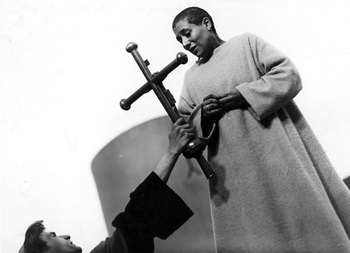|
The Passion of Joan of Arc is a remarkable classic of the silent era by the Danish director Carl Theodor Dreyer, depicting the trial and execution of Joan of Arc at the hands of the English. The film is frequently listed today as one of the greatest ever made, but has suffered numerous spates of bad luck in its lifetime and come perilously close to the dustbin of history. Dreyer's version was the eighth attempt to film the story of Joan of Arc, but was far from a simple retread of the well-known story. Dreyer believed that the key to a film depicting the dreadful fate of Joan of Arc was to be found in humanising the deified through realism, immersive dimensionality in composition and an honest conveyance of emotion. As Dreyer himself explains: “All of these pictures express the character of the person they show and the spirit of that time. In order to give the truth, I dispensed with ‘beautification’. My actors were not allowed to touch make-up and powder puffs and, from the first to the last scene, everything was shot in the right order.” Perhaps following the realist depths of Ken Loach and Mike Leigh this doesn’t seem like remarkable practice, but in the era of silent film Dreyer was carving out a revolutionary method. Dreyer was producing a pre-typical psychological drama, whereby repression, not just expression, would be seen in the subtlety of performance. The success of Dreyer’s methods are still remarked upon today, with particular praise given to the performance of Renee Jeanne Falconetti as Joan of Arc, who - in her only film - stands out amongst the hammy theatrics of mainstream silent era acting by embracing Dreyer's philosophy and fully engaging with his physically and emotionally draining methods. Roger Ebert remarked on her dedication: “For Falconetti, the performance was an ordeal. Legends from the set tell of Dreyer forcing her to kneel painfully on stone and then wipe all expression from her face--so that the viewer would read suppressed or inner pain. He filmed the same shots again and again, hoping that in the editing room he could find exactly the right nuance in her facial expression.”
Following 18 months of production, the finished film horrified the producers, the censors of many countries (particularly in Britain, due to the representation of the torture and abuse by the English court) and the Catholic church, and was subsequently edited in brutal fashion by various companies and authorities throughout international distribution. From clumsy additional voice-overs to significant and badly executed changes to the pacing and narrative, the changes were ham-fisted and destructive. The film, although critically acclaimed, was not accepted by audiences and faded into obscurity. This is perhaps unsurprising, due to its unconventional style and the clumsily edited and truncated versions released, which meant the complex and demanding film had been rendered confusing in its various edits. Dreyer's version of the film was never given much of a chance. Publically shown in its original state only once, by Dreyer himself in 1928, two different fires destroyed both the original negative and Dreyer's consequent reconstruction. These misfortunes, coupled with the studio’s lack of care in maintenance and storage, meant that Dreyer's film was lost. This was not an uncommon fate for films of the trail end of the silent era, those films that bled into the era of sound were thought of by the studios as completely outmoded. Robert A Harris, a film preservationist, has said of studio preservation: "Most of the early films did not survive because of wholesale junking by the studios. There was no thought of ever saving these films. They simply needed vault space and the materials were expensive to house." Despite sharing the pyric fate of it's heroine, The Passion eventually rose from the ashes when a complete and almost pristine copy of Dreyer’s original was found in a janitor’s cupboard in a Norwegian mental institution in 1981; a ‘Lazarus film’ in the lexicon of preservationists. This bizarre location seems a fitting place for such an oddity in the silent film canon, and its good condition in such an unusual and unsuitable location was regarded as nothing short of miraculous. Now cemented as a classic of cinema and considered far ahead of its time, the film receives the unqualified acclaim that Dreyer was unable to witness in his lifetime. Dreyer's doggedly pursued experimental philosophy, that was so alien to the contemporary audience, has now established this film as a unique and much examined part of cinema history.
0 Comments
Leave a Reply. |
Archives
November 2023
Categories
All
LinksWriting
Art & Design Science Music Film All contributions by Kieran Gosney unless otherwise stated.
© Kieran Gosney and kierangosney.com, 2013. Unauthorized use and/or duplication of this material without express and written permission from this blog’s author and/or owner is strictly prohibited. Excerpts and links may be used, provided that full and clear credit is given to Kieran Gosney and kierangosney.com with appropriate and specific direction to the original content.
|

 RSS Feed
RSS Feed